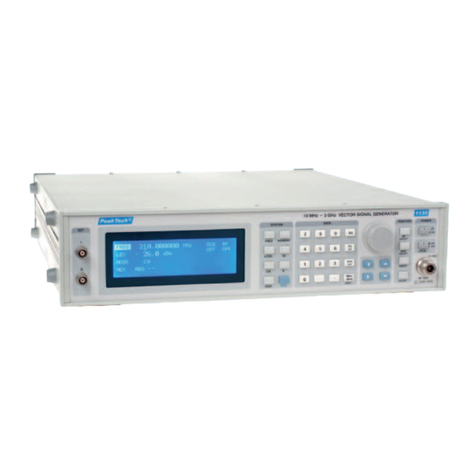
2. The PeakTech®4110 Universal System
Please read this operating manual very carefully, prior to operating the instrument.
2.1 Introduction
The PeakTech 4110 Universal System is a compact and powerful performance instrument, capable of meeting
various needs of laboratories, service-workshop, technical training institutes, schools, engineering, and
manufacturing fields, etc.
This instrument is characterized by a wide-range coverage of Function Generator, Universal Counter, DC Power
supply and Digital Multimeter in a single unit.
The PeakTech 4110 incorporates:
1. Function Generator, capable of generating seven (7) forms of wave, i. e. Sine, Square, Triangle,
Skewed Sine, Ramp, Pulse and TTL level square in the seven frequency range sourcing from
1 Hz to 10 MHz.
2. Universal Counter, capable of measuring the frequency ranges from 5 Hz to 1.3 GHz.
3. DC Power Supply, capable of generating the voltage carrying with 5 V/2 A, 15 V/1 A fixed and
0-30 V/0-3 A variable.
4. Digital Multimeter, capable of measuring DC/AC voltage up to 1.000 V DC/750 V AC (true rms), DC/AC
current up to 20 A, resistance up to 40 MΩ, capacitance up to 400 µF, and logic test (C-MOS/TTL). This
section can be hooked into data acquisition system run on Personal computers, printers or pen-plotters etc.,
through a RS-232 C serial interface connector.
2.2 Accessories
This instrument is supplied with the following accessories:
1 pce. Power cable
1 pce. Operation manual
1 pair Black & Red test leads
1 pce. Coaxial cable with BNC connector
1 pce. RS-232 C interface with cable connector
1 pce. 3 ½”-diskette with software for Windows and DOS
3. Safety Precautions
The following safety precautions must be observed at all times during operation, service, and repair of this product.
Failure to comply with these precautions, or with specific warnings elsewhere in this manual violates safety standards
of design, manufacture and intended use of the product. We assume no liability for failure to comply with these
requirements.
• Avoid an extremely hot or cold place for the instrument
• Ground the chassis and cabinet by only using a three-contact AC power cable which must be plugged into an
approved three-contact electrical outlet.
• Do not operate the instrument in wet, damp or explosive areas.
• Keep the instrument away from live circuits, a soldering iron, etc.
• Do not change parts or apply an unauthorized modification to the instrument.
• Make sure that any use of modified fuses or the short circuiting of the fuse-holders shall be prohibited.
• Use only the specified fuses for the instrument, as follows:
* Power line fuse: 1 A/220 V or 240 V
Shape: 6,35 ∅x 31,8
Type: Slow-blow
* DMM ampere fuses: 400 mA AC/DC Ranges: 800 mA/250 V
20 A AC/DC ranges: 20 A/250 V
Shape: 6,35 ∅x 31,8
Type:Fast-blow
- 22 -




























